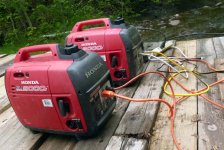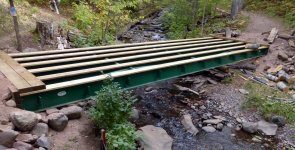Not an expert, but I have an opinion.
Bagged Quikrete is rated for 4000 psi. If the whole cabin weighs 25,000 lbs, you could support it on 6.25 square inches. That's a square 2.5 inches on a side. Alternately, assume the cabin is supported by a 2x4 sill on each side, and the entire weight is held by the eave sides. If it's 50 feet long, the bearing surface is 2 sides x 50 feet per side x 12 inches per foot x 3.5 inches wide= 4,200 square inches. With the same 25,000 lbs, that's under six pounds per square inch. That's about what your shoe produces standing on one foot. My point is the strength of the concrete is the least of your worries. With piers the load is going to be more concentrated, but your limiting factor is going to be the wood beams resting on the concrete, wood has a much lower crush rating than concrete.
Problems with concrete are most likely to come from errors in mixing or in placing. I would argue that you're more likely to make a mixing error if you're measuring materials yourself on site than if using pre-bagged.
A downside of bags is you have to have a way of storing them that keeps them dry. You'd have to keep the portland cement dry, but it's a lot less to worry about. I'm intrigued by the idea of bagged aggregate with separate bags of cement, sounds like the best of both worlds.
Cost is a wash, there would be less waste with bags as it's easier to make batches the size you need them and easier to store the surplus.
But the big determinant is materials handling. If you can figure out a way to get that 16,000 lbs of concrete in place without ever touching a shovel, bucket or wheelbarrow, bulk materials are the way to go. But it's much easier to pick up a bag than it is to shovel the same amount into a bucket. Doing 16,000 lbs with the "one shovel portland, two sand, three gravel" would make a man out of you.
When the material was sledded in, was it in the winter over snow, or just over land? Over snow is the traditional New England way of moving heavy objects. Winter was the shipping season.

